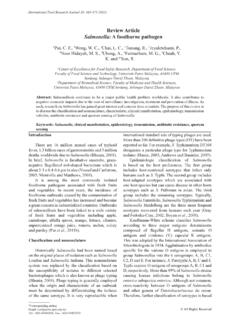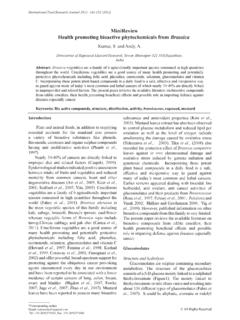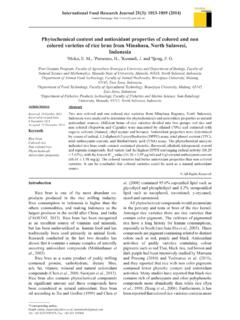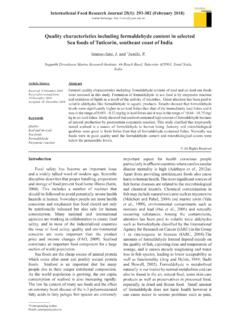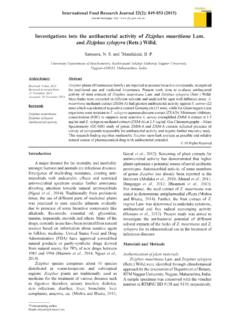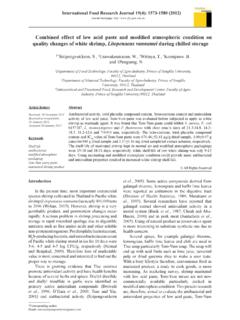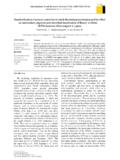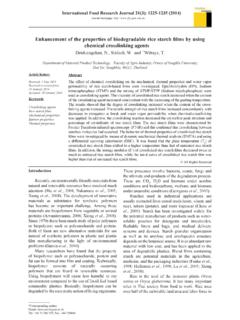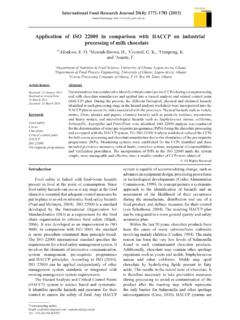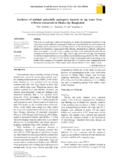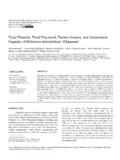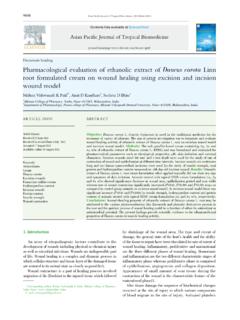Transcription of Screening of phytochemical content of commercial …
1 All Rights Reserved*Corresponding author. Email: International Food Research Journal 20(6): 3177-3184 (2013)Journal homepage: , N., 1 Chaalal, M., 2 Kadji, H. and 1*Louaileche, of Food Science, Laboratory of Applied Biochemistry, Faculty of Natural Sciences and Life, 2 Department of Physicochemical Biology, Faculty of Natural Sciences and Life, University Abderrahmane Mira, BEJAIA 06000, ALGERIAS creening of phytochemical content of commercial apricot- and orange-based beverages and its relationship with antioxidant capacityAbstractThe aim of the present research study was to compare the antioxidant properties of beverages based on apricot and orange fruits as well as to establish if the combination of these resulted in a beverage with high antioxidant content . For this purpose, the quantification of some antioxidants (total phenolic compounds (TP), ascorbic acid (AA) and proanthocianidins (PA)) using colorimetric assays and the determination of antioxidant activities of apricot- and orange-based beverages as well as their mixture were performed.
2 The results revealed that the combination of apricot- and orange-based beverages had antagonistic effect on TP and AA content , unlike PA content . Moreover, these antioxidants correlated positively with total antioxidant capacity. The principal component analysis showed cumulative variance of approximately 85% which mean that the chosen parameters had a high discriminate power and they can be a useful criterion for the determination of quality of commercial the last two decades there has been an increasing interest in determining relevant dietary sources of antioxidant compounds. Thus, in some countries like Algeria, Prunus and Citrus fruits have received attention due to their high consumption as they can be a good source of bioactive compounds such as phenolics and ascorbic acid (Ouchemoukh et al., 2013; Stinco et al., 2013) which have been implicated in the reduction of degenerative human diseases, mainly because of their antioxidant potential (Del Caro et al.)
3 , 2004; Klimczak et al., 2007).The agricultural food industry is now one of the most dynamic in Algeria, mainly in the field of juices and beverages. In 2008, the production achieved 19 million hectolitres while it was 12 million hectolitres in 2002 (Minist re du commerce, Alg rie, 2012), indicating that the consumption of beverages has rapidly increased, especially apricot- and orange-based beverages, which are widely consumed in Algeria. Fruit-based beverages, which are not juices, are known to constitute the primary source of naturally occurring antioxidants in the human diet; they possess many bioactive components that exert antioxidant and anticancer effects (Liu, 2003; Chira et al., 2008). Therefore, for health promotion and disease prevention, it could be of importance to know the total antioxidant capacity (TAC) of fruit-based beverages that represents the cumulative capacity of the dietary components to scavenge free radicals (Serrano et al.
4 , 2007; P rez-Jim nez et al., 2008). This concept reflects the integrated and/or synergistic effects of all antioxidants (Wu et al., 2004). The TAC may be viewed as a functional measure of a food or beverage, as it includes all the components with antioxidant capacity ( vitamin C and phenolic compounds). A determination of the TAC of food beverages could provide a possibly useful measure of their functionality (Barba et al., 2013). Several published articles have been conducted to study bioactive compounds and antioxidant capacity in apricot and orange juices (Aider and De Halleux, 2008; Versari et al., 2008; Stinco et al., 2013). However, in the literature available at present, there is a lack of information about the activity of antioxidants in apricot- and orange-based beverages. The aim of our study was to evaluate bioactive compounds (ascorbic acid, total phenolic component and proanthocyanidins) of commercial apricot- and orange-based beverages and their relationship with antioxidant capacity measured using eight in vitro antioxidant assays (H2O2, TBARS, FRP, CP, DPPH, SOSC, NO and HO tests), as there is an increasing number of this kind of food beverage commercialised in Algeria supermarkets, with new formulations, and the following nutritional interest by consumer.
5 Material and Methods Sample material Three units from each of two batches of KeywordsBioactive compounds Antioxidant capacity Apricot- and orange-based beveragesArticle historyReceived: 24 January 2013 Received in revised form: 10 July 2013 Accepted: 10 July 20133178 Touati et 20(6): 3177-3184commercial fruit-based beverages largely consumed in Algeria (apricot nectar, orange drink and cocktail) were used for the determinations. Apricot- and orange-based beverage had 40 and 12% of fruit content , respectively. The combination apricot- and orange-based beverages (cocktail) had 12% of fruit content with proportion of 20 and 80%, respectively. Samples were centrifuged (20 min, 3000 rpm) to remove Hydrogen peroxide, 1,1-Diphenyl-2-picrylhydrazyl (DPPH) and ferrozine were from Sigma Aldrich (Sternheim, Germany). Folin Ciocalteu reagent was from Biochem, Chemopharma (Montreal, Quebec); sodium carbonate, potassium ferricyanide, trichloroacetic acid (TCA) and hydrochloric acid were from Biochem, Chemopharma (Georgia, USA); 2-Deoxy-D-ribose and sodium nitroprusside were from Fluka BioChemica (Germany); ferric chloride was from Panreac (Barcelona, Spain); tris and ethylene-diamine-tetra-acetic acid (EDTA) were from BDH, Prolabo (CE).
6 All chemicals and solvents used were of analytical compounds quantificationThe total phenolic (TP) content was assessed according to Singleton and Rossi (1965). Aliquots (200 L) of sample were mixed with 1 mL of 10% Folin-Ciocalteu reagent and 800 L of sodium carbonate solution, and the absorbance (Shimadzu Uvi-mini 1240 spectrophotometer) was recorded at 765nm. The results were expressed as mg gallic acid equivalent (GAE) per 100 mL of beverage. Proanthocyanidins (PA) content was determined by the method based on acid hydrolysis and colour formation (Porter et al., 1986). Two millilitres of sample were mixed with 20 mL of Fe sulphate solution (77 mg of FeSO4-7H2O in 500 mL of HCl: n-butanol/2:3) and incubated for 15 min at 95 C. After cooling to room temperature, absorbance was measured at 530 nm. The results were expressed as mg cyanidin equivalent (CE) per 100 mL of beverage.
7 Ascorbic acid (AA) content was assessed by the DCPIP method (Klein and Perry, 1982). One millilitre of sample was mixed with 9 mL of 2,6-dichloro-indophenol (15 g/mL); the absorbance was read at 515 nm and the results were expressed as mg AA/100 mL of beverage. Antioxidant activityHydrogen peroxide scavenging capacity The scavenging capacity of fruit beverages against hydrogen peroxide was determined according to Ruch et al. (1989). The test tubes were prepared with mL of beverage and H2O2 (1 mL, 40 mM) in phosphate buffer ( M, pH ). After 10 min incubation, the absorbance was measured at 230 nm. The percentage of H2O2 inhibition effect was calculated using the following equation: Activity (%) = [(Ac-As)/Ac] x 100 (Eq. A)Where Ac and As are the absorbance of the control and the absorbance of the sample, acid reactive species test (TBARS) The determination of TBARS was based on the method reported by Daker et al.
8 (2008). Briefly, 100 L of beverage was added to a mixture that contained 1 mL of egg yolk in M phosphate buffer pH , and 100 L of 1 mM Fe2+. After incubation at 37 C for 1 h, 500 L of 15% TCA and 1 mL of 1% thiobarbituric acid were added to the mixture. After incubation at 95 C for 10 min, the tubes were centrifuged at 3500 rpm for 10 min, and the absorbance recorded at 532 nm. The inhibition of reactive species was calculated according to Eq. power (RP)The ferric reducing power of beverages was assessed according to Oyaizu (1986). Samples ( mL) were mixed with mL of phosphate buffer ( M, pH ) and mL of 1% potassium ferricyanide. After incubation (20 min at 50 C), mL of 10% TCA were added to the mixture. After centrifugation, mL of the upper layer were diluted with distilled water (v/v) and 500 L of ferric chloride were added. The absorbance was measured at 700 nm and the results were expressed as mg AAE/100 mL. Chelating power (CP) The chelating power of beverages on ferrous ions was examined as described by Dinis et al.
9 (1994). Volume of sample was mixed with same volume of 1 mM FeCl2 and mM ferrozine. After incubation for 10 min, the absorbance was read at 562 nm. The ferrous ion chelating capacity was calculated according to Eq. antiradical activity The antiradical activity of beverages on DPPH free radical was performed as reported by Brand-Williams et al. (1995). Aliquot (200 L) of sample was added to 1 mL DPPH methanolic solution (60 M). After incubation at room temperature for 30 min, the absorbance was recorded at 517 nm. The results were expressed as mg AAE/100 et 20(6): 3177-31843179 Superoxide scavenging capacity (SOSC) The superoxide scavenging capacity of beverages was measured according to the method of Jiao et al. (2005). Aliquot (200 L) of sample was added to mL of Tris-HCl (50 mM) and EDTA (2 mM) buffer solution (pH ). After incubation (25 C for 10 min), 80 L of pyrogallol (5 mM) were added.
10 The mixture was again incubated at 25 C for 3 min and the reaction was stopped by addition of drops of ascorbic acid. The absorbance was recorded at 420 nm and the SOSC was calculated according to Eq. oxide scavenging capacity (NO) The nitric oxide radical scavenging capacity of beverages was assayed using method reported by Ebrahimzadeh et al. (2010). The reaction mixture (800 L) containing sodium nitroprusside (10 mM) and sample was incubated at 25 C for 150 min. A volume of the mixture was removed and added with to an equal volume of the Griess reagent. The absorbance was measured at 540 nm and the inhibition of nitric oxide was calculated according to Eq. radical scavenging activity (HO )Hydroxyl radical scavenging capacity of beverages was determined according to the method described by Halliwell et al. (1987). The reaction mixture (100 L of sample diluted with phosphate buffer 50 mM, pH , 100 L of 60 mM 2-deoxy-ribose, 200 L of a premixed 4 mM FeCl3 and 4 mM EDTA 1:1, v/v, 100 L of 20 mM H2O2 and 100 L of 4 mM ascorbic acid) was incubated at 37 C for 1 h.
